An inexpensive way to decorate a garage space from block materials - concrete, foam block or cinder block - plastering. Plastering walls in the garage does not require special skills and is easy to do with your own hands.
Pros and cons of plastering walls
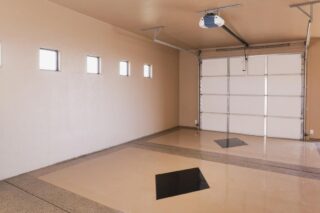
Car owners often use a garage to store tools and carry out repairs, spending a lot of time in this room. Therefore, it is important to create a microclimate that is comfortable to stay and does not have colds. Garage plaster inside serves decorative purposes and will help level the surface, protect the walls from mold and mildew.
Plastering is one of the most budgetary and easiest finishing options. If defects have appeared on the surface, it is easy to fill them with the compound again. The compounds used for plastering garage walls are non-flammable and do not absorb odors. They tolerate moisture well, so the painted surface can be washed.
The downside is the limited scope of application: such compositions are used for buildings built of blocks or bricks. To obtain a coating with decent performance, you need to choose a mixture that is suitable for the wall material and type of finish (exterior or interior), as well as adhere to the use technology described on the package.
Varieties of coverage
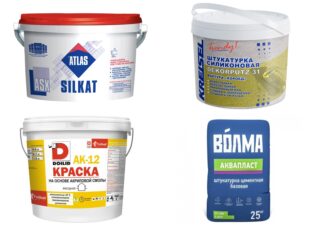
Plaster differs in its composition and properties.
Acrylic resin based
These are quick-drying formulations that tolerate moisture well. They are available in a wide range of shades. The coating is flexible, easy to clean, breathable. But most of these paints are not fire resistant. This property is inherent only in formulations with special additives.
Silicate
The price of such compositions is higher, but the coating has excellent performance properties. It tolerates precipitation and washing well, allows steam to pass through, and is resistant to aggressive chemical influences.
Silicone
These compounds adhere well to the surface, creating a durable and elastic coating that is resistant to moisture. The service life is the greatest. Unlike the previous group, they tolerate vibrations well. The price is quite high.
Cement
Cement mortar is the most unassuming option in terms of aesthetic qualities. Usually it is used for outdoor decoration, since the material requires a lot of water (the first time after application, the surface must be periodically moistened). The material is durable, frost-resistant, does not burn and does not let water into the depths. In addition, it is the most affordable coverage option.
Gypsum plaster is suitable for interior decoration of heated rooms, since the coating does not tolerate moisture well, as well as severe frosts. The composition is flexible and easy to apply. You need to cook in small portions because of the quick adhesion.
Choosing the best option
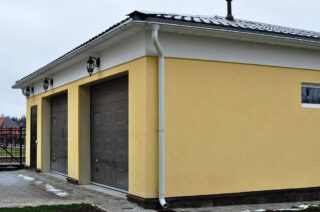
Since the ceiling is usually not subject to shock and abrasion, a high-strength coating is not required. But it is more difficult to plaster it than walls, so it is more convenient to take a composition that is easy to apply. If the room is heated, a plaster mix will do.
For walls, you can purchase an acrylic compound.The lower parts should be covered with a product with waterproofing properties.
For exterior decoration, a special facade composition is purchased. Walls can be painted with versatile products suitable for outdoor and indoor use. Indicators of moisture and frost resistance are selected taking into account the characteristics of the climate in the region.
Required tools and materials
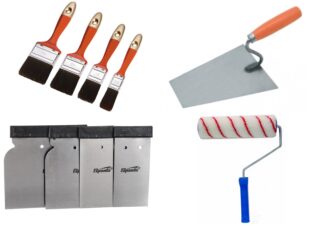
Before plastering the walls in the garage, you need to prepare consumables.
To calculate the amount of the mixture, they put 3 beacons on the wall - 2 on the most protruding and most distant points and 1 on any other. Their distance from the wall is summed up and divided by 3. This number is multiplied by the area to be treated, and the result obtained is by the composition consumption indicated on the package. Better to buy a mixture with a small stock.
From the toolkit you will need:
- roller for applying the composition;
- a set of brushes of different widths for processing hard-to-reach places;
- Master OK;
- a set of spatulas;
- rule;
- masking tape.
You should also prepare devices for marking and controlling evenness: building level, tape measure and marker. If, before plastering the garage, the walls are supposed to be reinforced with mesh, you need to purchase it as well.
Wall plastering technology
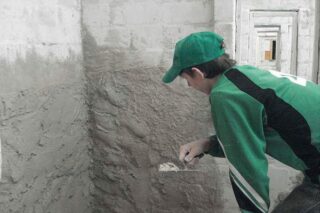
Painting should be done under suitable weather conditions: temperature indicators from +5 to +25 degrees and low air humidity (no more than 60%). The walls to be treated should not be exposed to direct sunlight. Communications must be disabled and protected.
Impurities, debris, fungal colonies are removed from surfaces, treated with an antiseptic. Before plastering a garage with uneven walls, you need to eliminate the differences using a cement-sand mixture. The brick is treated with a wire brush to improve adhesion.
Reinforcement mesh is used to achieve the desired coating thickness. Then it will last longer. Secure with dowels.
Using a plumb line, find the most protruding point and set the bar. Focusing on it, beacons are mounted. The distance between them is 1-1.5 meters. Fix them with cement mortar.
The first spray is applied to the moistened surface with a trowel, without leaving untreated areas. At the end of the day, they proceed to applying the primer. Having processed a segment of the area of about a square meter, they move on to the next section. Lighthouses need to be closed with a mixture, after which it is leveled with a rule. When the composition is set, the beacons are removed. The wells are filled with a mixture and leveled with a spatula.
Covering is done for coloring. A spatula with rounded corners is used, with which the mixture is applied in a thin layer. After drying, the surface is sanded with fine emery paper.
Using a robot will help save time and effort. The solution is poured inside, the device is turned on, it begins to process the surface. When calibrating the parameters, follow the instructions in the instructions.
In an unheated garage, wall surfaces are saturated with moisture, so they need a hydrophobic composition. If a mixture that does not have these properties is used as a base, the hydrophobic paint is applied on top.
You can clean the plastered surface with a dry cloth or vacuum cleaner. If the mixture is not afraid of water, if dirt appears, the coating can be washed with a wet sponge.








